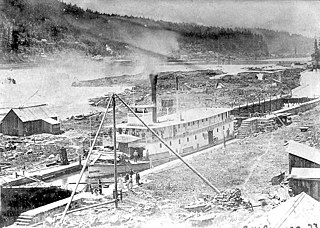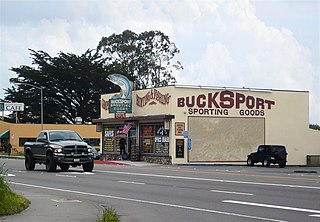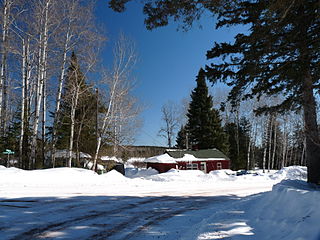
Grand Rapids is a city in Itasca County, Minnesota, United States, and it is the county seat. The population was 11,126 at the 2020 census. The city is named for the 3.5-mile (5.6 km) long rapids in the Mississippi River which was the uppermost limit of practical steamboat travel during the late 19th century. Today the rapids are hidden below the dam of UPM Paper Company.

A log flume or lumber flume is a watertight flume constructed to transport lumber and logs down mountainous terrain using flowing water. Flumes replaced horse- or oxen-drawn carriages on dangerous mountain trails in the late 19th century. Logging operations preferred flumes whenever a reliable source of water was available. Flumes were cheaper to build and operate than logging railroads. They could span long distances across chasms with more lightweight trestles.

McCarthy Beach State Park is a state park of Minnesota, USA, on the Sturgeon Lake chain near Hibbing. It is located in French Township, Saint Louis County.

The St. Croix Boom Site is a historic and scenic wayside on the St. Croix River in Stillwater Township, Minnesota, United States. It commemorates the location of a critical log boom where, from 1856 to 1914, timber from upriver was sorted and stored before being dispatched to sawmills downstream. The site was developed as a roadside park along Minnesota State Highway 95 in the 1930s. In 1966 it was designated a National Historic Landmark for its national significance in the theme of industry. It was nominated for being the earliest, most important, and longest serving of the log storage and handling operations that supported Minnesota's major logging industry. Virtually no traces remain of the site's original buildings and structures.
The Ilwaco Railway and Navigation Company operated a 3 ft narrow gauge railroad that ran for over forty years from the bar of the Columbia River up the Long Beach Peninsula to Nahcotta, Washington, on Willapa Bay. The line ran entirely in Pacific County, Washington, and had no connection to any outside rail line. The railroad had a number of nicknames, including the "Clamshell Railroad" and the "Irregular, Rambling and Never-Get-There Railroad."

The Willamette River flows northwards down the Willamette Valley until it meets the Columbia River at a point 101 miles from the Pacific Ocean, in the U.S. state of Oregon.

Bucksport was a town in Humboldt County, California. The original location was 2.5 miles (4 km) southwest of downtown Eureka, on Humboldt Bay about 5 miles (8 km) northeast of entrance. at an elevation of 16 feet (4.9 m). Prior to American settlement a Wiyot village named Kucuwalik stood here.

Splitrock is an abandoned townsite in Beaver Bay Township, Lake County, Minnesota, United States; located at the mouth of the Split Rock River.

Andersonia is an unincorporated community in Mendocino County, California. It is located near U.S. Route 101 on the South Fork of the Eel River 1 mile (1.6 km) north-northwest of Piercy, at an elevation of 541 feet.
The Finkbine-Guild Lumber Company was established to harvest and market the virgin longleaf pine stands of southern Mississippi during the early 20th century. The main sawmills were located in Wiggins and D'Lo, Mississippi. When the local timber supply dwindled, the company tried to utilize redwood trees from California, but that operation failed because of high transportation costs. Other attempts were made at promoting a more diversified use of the cutover timberlands; some ventures were successful while others were not.
The Red River Railroad, also known as the Ralph Smith Smith Railroad and the Alexandria and Cheneyville Railroad, was the first railroad in the United States built west of the Mississippi River.

Kennedy is an unincorporated community located in the town of Lake, Price County, Wisconsin, United States. Once a busy sawmill community during the logging boom, Kennedy is now a ghost town.

Morse is an unincorporated community located in the town of Gordon, Ashland County, Wisconsin, United States. Morse is located along the Bad River 7.5 miles (12.1 km) south-southeast of Mellen.
Shanagolden is an unincorporated community located in the town of Shanagolden, Ashland County, Wisconsin, United States. Shanagolden is located on the East Fork Chippewa River 10 miles (16 km) northwest of Butternut.
The Seboomook Lake and Saint John Railroad was a forest railway built to transfer pulpwood between drainage basins in the Maine North Woods. The railroad was built slowly in preparation for anticipated pulpwood harvesting, but onset of the Great Depression caused the railroad to be dismantled when harvesting plans were delayed.
Black Rock is an unincorporated community and former logging camp in Polk County, Oregon, United States. It is located about three miles west of Falls City, in the Central Oregon Coast Range on the Little Luckiamute River.
The Red Deer Lumber Company was a forestry company that had approximately 10 logging operations along the Red Deer River, and owned and operated a sawmill on the south shore of Red Deer Lake.
Herman Finger (1856-1929) was a lumberman who owned and operated various lumber companies that operated in Wisconsin, Minnesota, Ontario, Manitoba, and Saskatchewan. He also served as the first mayor of The Pas after its establishment in 1912.

The Madera Sugar Pine Company was a United States lumber company that operated in the Sierra Nevada region of California during the late 19th and early 20th centuries. The company distinguished itself through the use of innovative technologies, including the southern Sierra's first log flume and logging railroad, along with the early adoption of the Steam Donkey engine. Its significant regional impact led to the establishment of towns such as Madera, Fish Camp, and Sugar Pine, as well as the growth of Fresno Flats and the formation of Madera County.

The Sugar Pine Lumber Company was an early 20th century logging operation and railroad in the Sierra Nevada. Unable to secure water rights to build a log flume, the company operated the “crookedest railroad ever built." They later developed the Minarets-type locomotive, the largest and most powerful saddle tank locomotive ever made. The company was also a pioneer in the electrification of logging where newly plentiful hydroelectric power replaced the widespread use of steam engines.